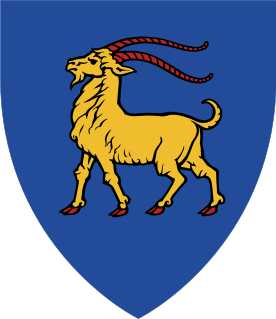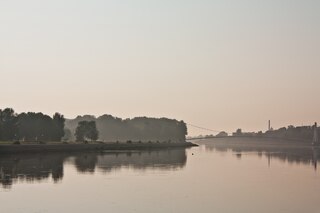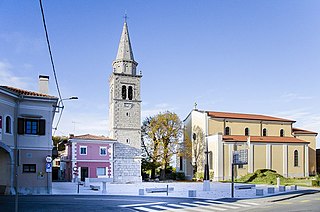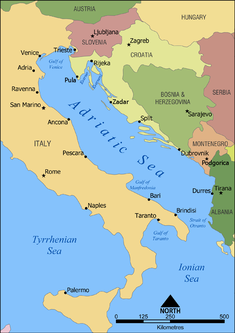
Istria, formerly Histria (Latin), Ἴστρια, is the largest peninsula within the Adriatic Sea. The peninsula is located at the head of the Adriatic between the Gulf of Trieste and the Kvarner Gulf. It is shared by three countries: Croatia, Slovenia, and Italy. Croatia encapsulates most of the Istrian peninsula with its Istria County.

The Drava or Drave is a river in southern Central Europe. With a length of 710 kilometres (440 mi), 724 kilometres (450 mi) including the Sextner Bach source, it is the fifth or sixth longest tributary of the Danube, after the Tisza, Sava, Prut, Mureș and perhaps Siret. The Drava drains an area of about 40,154 km2 (15,504 sq mi). Its mean annual discharge is seasonally 500 m3/s (18,000 cu ft/s) to 670 m3/s (24,000 cu ft/s). Its source is near the market town of Innichen, in the Puster Valley of South Tyrol, Italy. The river flows eastwards through East Tirol and Carinthia in Austria into the Styria region of Slovenia. It then turns southeast, passing through Croatia and, after merging with its main tributary Mur, forms most of the border between Croatia and Hungary, before it joins the Danube near Osijek.

The Mur or Mura is a river in Central Europe rising in the Hohe Tauern national park of the Central Eastern Alps in Austria with its source being 1,898 m (6,227 ft) above sea level. It is a tributary of the Drava and subsequently the Danube.

The Illyrian Provinces were an autonomous province of France during the First French Empire that existed under Napoleonic Rule from 1809 to 1814. The province encompassed modern-day Slovenia, Gorizia, Trieste, and parts of Croatia and Austria. Its capital was Ljubljana in Slovenia. It encompassed six départements, making it a relatively large portion of territorial France at the time. Parts of Croatia were split up into Civil Croatia and Military Croatia, the former served as a residential space for French immigrants and Croatian inhabitants and the latter as a military base to check the Ottoman Empire.

An alpine garden is a domestic or botanical garden, or more often a part of a larger garden, specializing in the collection and cultivation of alpine plants growing naturally at high altitudes around the world, such as in the Caucasus, Pyrenees, Rocky Mountains, Alps, Himalayas and Andes. It is one of the most common types of rock garden.

The Žumberak Mountains is a range of hills and mountains in northwestern Croatia and southeastern Slovenia, extending from the southwest to the northeast between the Krka and the Kupa.

Welschriesling is a white wine grape variety, unrelated to the Rhine Riesling, that is grown throughout Central Europe.

Sežana is a town in the Slovenian Littoral region of Slovenia, near the border with Italy. It is the seat of the Municipality of Sežana. Sežana is located on the Karst Plateau, 17 kilometres from Trieste, Italy, and 80 km (50 mi) from Ljubljana, the capital city of Slovenia.

Anthemis arvensis, also known as corn chamomile, mayweed, scentless chamomile, or field chamomile is a species of flowering plant in the genus Anthemis, in the aster family. It is used as an ornamental plant.

Homogyne alpina, the Alpine coltsfoot or purple colt's-foot, is a rhizomatous herb in the family Asteraceae, which is often used as an ornamental plant. In addition, this plant has purple-red flowers, and it is usually associated with the gall flies Ensina sonchi and Acidia cognata.

The Eurovision Young Musicians 2002 was the eleventh edition of the Eurovision Young Musicians, held at Konzerthaus in Berlin, Germany on 19 June 2002. Organised by the European Broadcasting Union (EBU) and host broadcaster Zweites Deutsches Fernsehen (ZDF), musicians from seven countries participated in the televised final. A total of twenty countries took part in the competition. All participants performed a classical piece of their choice accompanied by the Deutsches Symphonie-Orchester Berlin, conducted by Marek Janowski. Czech Republic and Romania made their début while six countries returned to the contest, they were Croatia, Cyprus, Denmark, Greece, Italy and Sweden.
A cadastral community or cadastral municipality, is a cadastral subdivision of municipalities in the nations of Austria, Bosnia and Herzegovina, Croatia, the Czech Republic, Serbia, Slovakia, Slovenia, the Netherlands and the Italian provinces of South Tyrol, Trentino, Gorizia and Trieste. A cadastral community records property ownership in a cadastre, which is a register describing property ownership by boundary lines of the real estate.

Hieracium lachenalii, also known as common hawkweed or yellow hawkweed, is a species of plant in the dandelion tribe within the sunflower family. It is native to Europe but has become established as a weed in Australia and parts of North America. The species was widely known for many years as H. vulgatum, but more recent studies have indicated that the two names represent the same species. The name H. lachenalii was coined in 1802, H. vulgatum in 1819, so the older name is to be used.

Senecio vernalis is one of the European species of Senecio, an annual that is also known as eastern groundsel. While it has been long classified as Senecio vernalis, this species has more recently been described as a subspecies of Senecio leucanthemifolius and is now included by some in that species.

The Adriatic Sea is a body of water separating the Italian Peninsula from the Balkans. The Adriatic is the northernmost arm of the Mediterranean Sea, extending from the Strait of Otranto to the northwest and the Po Valley. The countries with coasts on the Adriatic are Albania, Bosnia and Herzegovina, Croatia, Italy, Montenegro and Slovenia.

Sorbus graeca, also known as the Greek whitebeam and fan-leaved service-tree is a species of whitebeam, member of the genus Sorbus in the rose family (Rosaceae).
The 2009 European Women Sevens Championship was the seventh edition of the European Women's Sevens Championship.
Asperula purpurea is a species of flowering plant in the family Rubiaceae. It was first described in 1974 and is endemic to France, Switzerland, Italy, Austria, Slovenia, Serbia, Bosnia and Herzegovina, Montenegro, Croatia, Romania, Albania, Greece, and Turkey.















